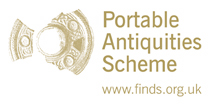File:Nail Scraper Fragment (FindID 485103).jpg

Original file (688 × 613 pixels, file size: 89 KB, MIME type: image/jpeg)
Captions
Captions
Summary
[edit]| Nail Scraper Fragment | |||
|---|---|---|---|
| Photographer |
Sussex Archaeological Society, Toby, 2012-01-30 12:04:08 |
||
| Title |
Nail Scraper Fragment |
||
| Description |
English: A fragment of a cast copper alloy implement with suspension loop, most likely a Roman nail cleaner or similar toilet implement. It is probable that this nail cleaner dates to the c. late 3rd-c. late 4th century AD; however, due to its fragmented state specific dating is uncertain. The fragment consists of a circular integrally-cast suspension loop oriented parallel to the blade. Below the suspension loop, crudely incised horizontal lines run at either side of a long, narrow neck, which is attached to a very narrow leaf-shaped, flat-sectioned blade. The blade seems to taper towards the nail cleaner end but approximately one-third to one-half of the blade and cleaner end are missing. The remains of the blade are decorated with incised lines running the perimeter of the blade and a third line running vertically down the centre of the blade. The colour of the metal is an even reddish-brown colour and there is a higher degree of corrosion on the reverse side; however, it is clear that the material is copper alloy. The object measures 22.65 mm long, 5.59 mm wide (max), 3.37 mm thick and weighs 1.13 grams.
Although very similar in style to some of the 'Baldock Type' nail cleaners mentioned in Nina Crummy's report in Lucerna 2001 (pp2-6), the suspension loop's orientation as parallel to the blade, the narrowness and general shape of the blade itself and its decoration suggest that this example dates to the late Roman period, as discussed by Crummy (Lucerna 2001, p6). However, a similar example from the PAS database has been listed as the former type:LEIC-31C2E2. |
||
| Depicted place | (County of findspot) Kent | ||
| Date | between 250 and 400 | ||
| Accession number |
FindID: 485103 Old ref: SUSS-686F77 Filename: MARTIN POLLARD 1.jpg |
||
| Credit line |
|
||
| Source |
https://finds.org.uk/database/ajax/download/id/367309 Catalog: https://finds.org.uk/database/images/image/id/367309/recordtype/artefacts archive copy at the Wayback Machine Artefact: https://finds.org.uk/database/artefacts/record/id/485103 |
||
| Permission (Reusing this file) |
Attribution-ShareAlike License | ||
Licensing
[edit]- You are free:
- to share – to copy, distribute and transmit the work
- to remix – to adapt the work
- Under the following conditions:
- attribution – You must give appropriate credit, provide a link to the license, and indicate if changes were made. You may do so in any reasonable manner, but not in any way that suggests the licensor endorses you or your use.
- share alike – If you remix, transform, or build upon the material, you must distribute your contributions under the same or compatible license as the original.
File history
Click on a date/time to view the file as it appeared at that time.
| Date/Time | Thumbnail | Dimensions | User | Comment | |
|---|---|---|---|---|---|
| current | 13:22, 3 February 2017 |  | 688 × 613 (89 KB) | Fæ (talk | contribs) | Portable Antiquities Scheme, SUSS, FindID: 485103, medieval, page 6533, batch primary count 37997 |
You cannot overwrite this file.
File usage on Commons
The following page uses this file:
Metadata
This file contains additional information such as Exif metadata which may have been added by the digital camera, scanner, or software program used to create or digitize it. If the file has been modified from its original state, some details such as the timestamp may not fully reflect those of the original file. The timestamp is only as accurate as the clock in the camera, and it may be completely wrong.
| Width | 4,773 px |
|---|---|
| Height | 4,718 px |
| Bits per component |
|
| Pixel composition | RGB |
| Orientation | Normal |
| Number of components | 3 |
| Horizontal resolution | 300 dpi |
| Vertical resolution | 300 dpi |
| Software used | [[w:Adobe Photoshop CS5 (12.0x20100115 [20100115.m.998 2010/01/15:02:00:00 cutoff; m branch]) Windows|Adobe Photoshop CS5 (12.0x20100115 [20100115.m.998 2010/01/15:02:00:00 cutoff; m branch]) Windows]] |
| File change date and time | 13:43, 11 November 2011 |
| Exif version | 2.21 |
| Color space | Uncalibrated |
| Date and time of digitizing | 18:59, 4 November 2011 |
| Date metadata was last modified | 13:43, 11 November 2011 |
| Unique ID of original document | xmp.did:2160EB206B0CE111BBE5AD26F32689ED |
| IIM version | 97 |
